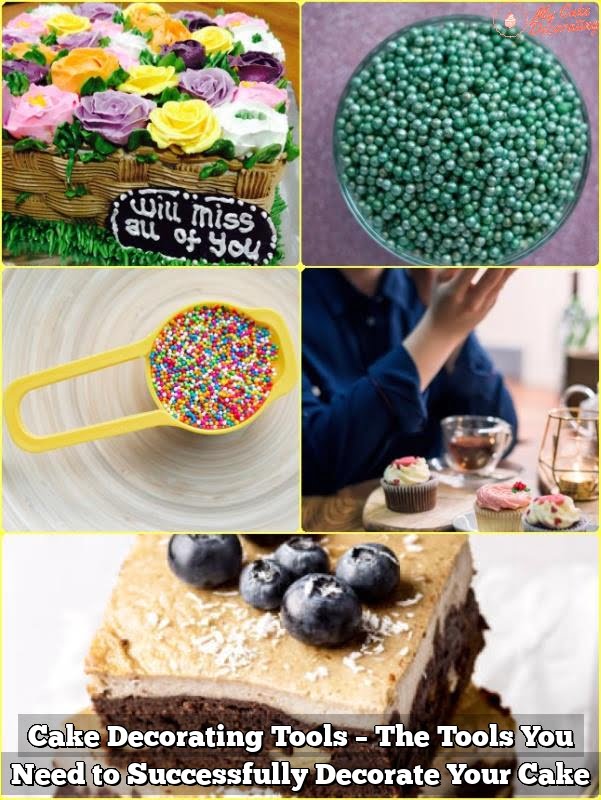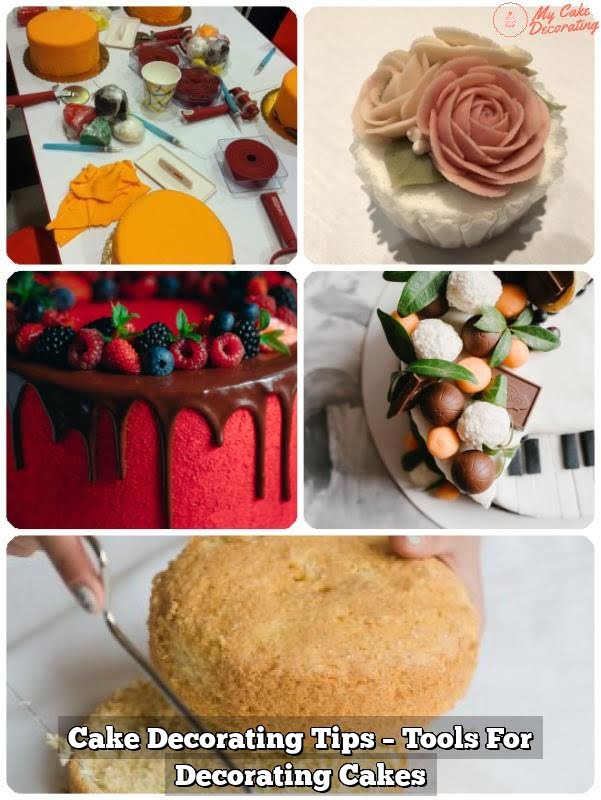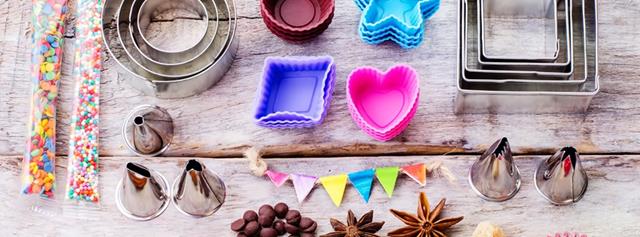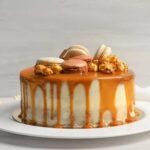Cake decorating is a delightful and imaginative craft that allows individuals to transform plain cakes into edible works of art. Whether you are a professional baker or someone who simply enjoys baking as a hobby, using the right tools is crucial for achieving professional-looking results.
This article will serve as a comprehensive guide to the various tools that are essential for cake decorating, providing detailed explanations on their purpose and functionality. From classic tools like piping bags and decorating tips to innovative options such as airbrushing equipment, this article will equip you with the knowledge needed to elevate your cake decorating skills.
Cake decorating is more than just adding icing and sprinkles; it is an art form that allows individuals to express their creativity and showcase their unique style. By exploring different techniques and utilizing the appropriate tools, bakers can create stunning designs on cakes that are not only visually appealing but also delectable.
If you aspire to decorate cakes professionally or simply want to improve your skills, it is important to understand the importance of using the right tools. The tools you use greatly influence the outcome of your decoration, ensuring precision, control, and consistency in your designs. By investing in high-quality tools specifically designed for cake decorating, you can achieve professional-looking results while making the process more enjoyable.
In the following sections of this article, we will discuss the must-have cake decorating tools including piping bags, decorating tips, cake stencils, fondant tools, airbrushing equipment, as well as other innovative decorative tools. Additionally, we will provide recommendations for both high-quality and affordable options available in the market. So let’s dive into the world of cake decorating tools and unleash our creativity together.
Essential Cake Decorating Tools
Cake decorating is an art form that allows individuals to express their creativity and create beautiful and delicious treats. To achieve professional-looking results, it is essential to have the right tools at your disposal. This section will provide a must-have checklist of essential cake decorating tools, discuss their purposes and functionalities, and offer recommendations for high-quality and affordable options.
One of the most basic but crucial tools for cake decorating is a turntable or cake stand. This rotating platform allows you to easily access all sides of the cake while applying frosting or other decorations. It ensures a smooth and even application, resulting in a polished finish. There are various options available, including both manual and electric turntables, depending on your preference and budget.
Another indispensable tool is an offset spatula. This long, narrow spatula with a bend in the blade is perfect for icing cakes, spreading fillings, and creating smooth finishes. The offset design provides better control as it keeps your hand further away from the cake surface. Look for an offset spatula with a comfortable grip and a flexible yet sturdy blade.
A piping set is also essential in any baker’s arsenal. This set typically includes different piping tips that allow you to create a variety of designs such as rosettes, borders, and lettering. It also comes with piping bags to hold your frosting or buttercream. Consider investing in high-quality stainless steel tips that are durable and easy to clean.
| Tool | Purpose | Recommended Option |
|---|---|---|
| Turntable/cake stand | To rotate cakes for easy access while decorating | Wilton Trim ‘n Turn PLUS Cake Decorating Turntable |
| Offset spatula | To ice cakes and create smooth finishes | Ateco 1385 Offset Spatula with 4.25-Inch Stainless Steel Blade |
| Piping set (tips and bags) | To create various designs using frosting or buttercream | Wilton Master Decorating Tip Set with Piping Bags |
Having these essential tools in your cake decorating toolkit will significantly enhance the quality of your decorated cakes. Whether you’re a beginner or a seasoned baker, investing in high-quality tools will enable you to achieve professional-looking results and make your cake decorating journey even more enjoyable.
Types of Decorating Tips
Decorating tips are an essential part of cake decorating, as they determine the designs and effects that can be achieved. There are various types of decorating tips available, ranging from basic to advanced options. Understanding the different types of tips and how they create unique decorations is key to mastering the art of cake decorating.
Types of Decorating Tips
- Round Tips: Round tips are versatile and commonly used for creating outlines, writing, dots, beads, and borders. They come in various sizes, with larger round tips being ideal for filling in larger areas or creating smooth textures.
- Star Tips: Star tips have a jagged edge that helps create beautiful stars, rosettes, shells, ruffles, and swirls. These tips come in different sizes and produce different-sized stars or patterns depending on the pressure applied.
- Petal Tips: Petal tips have a curved edge that allows for the creation of realistic flower petals. They are ideal for making flowers such as roses, tulips, and daisies. Different petal tips can create a variety of petal shapes and sizes.
- Leaf Tips: Leaf tips have a teardrop shape with a pointed end that allows for easy creation of leaves on flowers or other foliage designs. They come in various sizes to create different leaf shapes and textures.
Understanding how to use each type of tip opens up endless possibilities for cake decoration. By combining different tip designs and techniques, decorators can achieve intricate patterns and stunning designs on their cakes.
For example:
- A round tip can be used to outline a design or write a personalized message on a cake.
- A star tip can be used to create beautiful borders or piped flowers such as roses.
- A petal tip can be used to make lifelike flower petals for floral arrangements on cakes.
Experimenting with different types of decorating tips is an excellent way to unleash creativity and take cake decorating skills to the next level. It is important to practice using each tip to understand how it creates different designs and effects. By mastering the use of various tips, decorators can elevate their cake decorations and achieve professional-looking results.
Inspiring Examples
- A cake decorated with round tips to create intricate lace patterns.
- A wedding cake adorned with star tip borders and elegant rosettes.
- A birthday cake featuring a vibrant bouquet of flowers made using petal tips.
- A nature-themed cake embellished with realistic leaf decorations made using leaf tips.
These examples demonstrate the versatility and beauty that can be achieved by utilizing different types of decorating tips. Whether creating simple patterns or intricate designs, the right choice of decorating tip plays a significant role in achieving desired results.
Piping Bags and Their Uses
Piping bags are an essential tool for any cake decorator. They allow for precise control when it comes to adding decorative elements such as frosting, buttercream, or whipped cream to a cake. In this section, we will explore the different types and sizes of piping bags, provide step-by-step instructions on how to use and fill them, and share tips and tricks for achieving smooth and controlled piping.
There are two main types of piping bags: disposable and reusable. Disposable piping bags are convenient because they can be thrown away after use, saving time on clean-up. However, they are not as durable as reusable ones and may burst if too much pressure is applied.
Reusable piping bags are made from sturdy materials like silicone or cloth and can withstand more pressure without tearing. They do require thorough cleaning after each use but can be used repeatedly, making them a cost-effective option in the long run.
When it comes to size, piping bags range from small to large. Smaller bags are perfect for intricate detailing work or writing on cakes, while larger ones are suited for covering larger areas with frosting or creating bold designs. It’s important to choose the right size based on the task at hand to ensure optimal performance.
To use a piping bag effectively, start by fitting it with a decorating tip of your choice. There are many different tips available that create various designs and effects – from round tips for basic lines or dots to star tips for rosettes or shells.
Once your tip is attached securely, fill the bag with your desired icing or cream using either a spatula or piping bag filling set until it reaches about two-thirds full. Twist the top of the bag tightly to prevent leakage and apply steady pressure when squeezing the bag to pipe out your design.
| Type | Pros | Cons |
|---|---|---|
| Disposable Piping Bags | – Convenient
| – Not as durable
|
| Reusable Piping Bags | – Durable
| – Require thorough cleaning after each use
|
Cake Stencils and How to Use Them for Beautiful Designs
Cake stencils are essential tools that can elevate your cake decorating game and help you create beautiful and professional designs. These versatile tools come in a wide range of designs, from simple patterns to intricate motifs, giving you endless possibilities for creativity. In this section, we will explore the world of cake stencils, learn how to use them effectively, and discover creative ideas for incorporating them into your cake designs.
Introduction to Cake Stencils
Cake stencils are sheets of plastic or paper with cut-out designs that can be placed on top of a cake to create intricate patterns or motifs. They are available in various shapes and sizes, catering to different design preferences. Whether you want a classic lace pattern or modern geometric shapes, there is a stencil out there for you.
Using Cake Stencils for Clean Designs
Using cake stencils may seem daunting at first, but with the right technique, you can achieve clean and precise patterns effortlessly. Here is a step-by-step guide on how to use cake stencils effectively:
- Prepare your cake by frosting it smoothly.
- Secure the stencil firmly onto the cake using either tape or pins.
- Apply powdered sugar or cocoa powder over the stencil using a sifter.
- Gently lift off the stencil from one edge to reveal the design.
- If desired, enhance the pattern by adding edible glitter or colored icing.
Creative Ideas for Using Cake Stencils
Cake stencils offer endless possibilities for creativity in cake decorating. Here are some inspiring ideas for incorporating stencils into your cake designs:
- Create a focal point by placing a large stencil design in the center of your cake.
- Use smaller stencils to create a border around the cake or individual tiers.
- Incorporate different stencil designs in complementary colors for a multi-dimensional effect.
- Experiment with metallic food spray or luster dust on stenciled designs for added glamour.
- Combine different techniques, such as airbrushing or piping, with stenciling for intricate and unique designs.
Cake stencils are an excellent tool for achieving professional-looking designs on your cakes. With a little practice and creativity, you can take your cake decorating skills to new heights and impress your friends and family with stunning designs. So don’t be afraid to experiment, embrace your artistic side, and have fun creating beautiful cakes using cake stencils.
Fondant Tools and Techniques
Fondant has become an essential element in cake decorating, allowing bakers to create beautifully smooth and flawless finishes. This pliable icing-like substance provides a blank canvas for intricate designs, making it a favorite among professional cake decorators. To achieve stunning fondant creations, it is important to have the right tools and techniques at your disposal. In this section, we will explore fondant tools and their role in taking cake decorating to the next level.
Understanding Fondant
Before delving into the tools needed for working with fondant, it is important to understand what fondant is and its role in cake decoration. Fondant is a smooth icing made from sugar, water, and other ingredients that can be rolled out like dough. It creates a seamless look on cakes and allows for intricate detailing.
With fondant, you can achieve sharp edges, sculpted decorations, and even 3D designs on your cakes. It also provides a blank canvas for painting or airbrushing designs onto cakes.
Essential Fondant Tools
To work with fondant effectively, several essential tools are needed:
- Rolling Pin: A long rolling pin specifically designed for rolling out fondant helps achieve an even thickness and prevents sticking.
- Cutters: Fondant cutters come in various shapes and sizes to create different designs such as flowers, letters, or geometric patterns.
- Smoother: A fondant smoother helps remove wrinkles or air bubbles while providing a smooth finish on the surface of the cake.
- Embossing Tools: These tools add texture or patterns to fondant icing by pressing them onto the surface.
- Modeling Tools: Modeling tools are used to shape and manipulate fondant into different figures or decorative elements.
Covering a Cake with Fondant
To achieve a flawless finish when covering a cake with fondant, follow these steps:
- Prepare the Cake: Frost the cake with a thin layer of buttercream icing to help the fondant adhere smoothly.
- Roll Out Fondant: Dust your work surface with powdered sugar or cornstarch to prevent sticking and roll out the fondant to your desired thickness.
- Apply Fondant to Cake: Carefully lift the rolled-out fondant using a rolling pin or by draping over your arm, and place it gently on top of the cake.
- Smooth and Trim Excess Fondant: Use a fondant smoother to press and smooth out any air bubbles or wrinkles. Trim off excess fondant using a sharp knife or pizza cutter.
- Decorate as Desired: Now that your cake is covered in fondant, you can decorate it further by adding additional embellishments such as molded figures, flowers, or painted designs.
With these tools and techniques at your fingertips, you can take your cake decorating skills to new heights by working with fondant. Remember to practice patience and precision as you work with this versatile medium. The possibilities are endless when it comes to designing beautiful cakes using fondant as your canvas.
Airbrushing
Introduction to Airbrushing
Airbrushing is a popular technique used in cake decorating to add color and depth to cake decorations. It allows decorators to achieve vibrant and intricate designs with ease, creating stunning visual effects on cakes. Whether you are a beginner or an experienced decorator, incorporating airbrushing into your repertoire can take your cake decorating skills to the next level.
Necessary Equipment and Supplies
To successfully incorporate airbrushing into your cake decorating, you will need some essential equipment and supplies. First and foremost, you will need an airbrush kit, which typically includes an air compressor and an airbrush gun. It is important to invest in a high-quality airbrush kit that offers precise control over the airflow and spray pattern.
In addition to the airbrush gun and compressor, you will also need food coloring specifically designed for airbrushing. These food colors are formulated to be used in an airbrush gun without clogging or affecting its performance. They come in a wide range of shades, allowing you to create various color gradients and effects on your cakes.
Different Airbrushing Techniques
There are several techniques one can utilize when it comes to airbrushing cakes. One of the most popular techniques is called “basic spraying,” where decorators apply a sheer layer of color across the entire surface of the cake. This technique creates a smooth and vibrant base that can serve as a canvas for more detailed designs.
Another technique is known as “stenciling,” which involves using specially designed stencils to create patterns or images on the cake’s surface. The stencils act as guides while spraying colored edible paints onto the cake, resulting in clean and precise designs.
For those looking to add more depth and dimension, “shadowing” is a technique that involves layering different shades of color strategically to create shadows and highlights on the cake’s surface. This technique adds depth and realism to decorative elements such as flowers or figurines.
With practice and experimentation, decorators can combine these techniques to create unique and eye-catching cake designs that are sure to impress.
Whether you’re looking to add a pop of color, create intricate designs, or achieve a smooth gradient effect on your cakes, airbrushing is a versatile and fun technique to explore. By investing in the necessary equipment and supplies and learning different airbrushing techniques, you can elevate your cake decorating skills and create stunning works of edible art.
Beyond Traditional Tools
When it comes to cake decorating, there are a plethora of traditional tools that can be used to create beautiful designs. However, for those looking to push the boundaries and try something new, there are also innovative and fun decorative tools available. These unconventional tools can help elevate your cake decorations and add a unique touch to your creations.
One such tool is the cake comb. A cake comb is a versatile tool that allows you to create textured patterns on the sides of your cake. By simply dragging the comb through buttercream or fondant, you can achieve stunning effects such as waves, stripes, or even intricate geometric designs. Cake combs come in different designs and sizes, allowing you to experiment with various patterns and styles.
Another fun tool to explore is an embossing mat. Embossing mats are typically made of silicone and feature raised patterns that can be pressed onto fondant or gum paste to create intricate details. These mats come in a wide range of designs, from floral motifs to geometric patterns. By using an embossing mat, you can easily add texture and dimension to your cake decorations.
Sculpting tools are also worth considering for more advanced cake decorators who want to add sculptural elements to their cakes. Sculpting tools allow you to shape fondant or gum paste into three-dimensional objects such as flowers, figurines, or even architectural details. With a set of sculpting tools in hand, you can bring your creative visions to life and impress your friends and family with truly unique cake designs.
Incorporating innovative and fun decorative tools into your cake decorating journey allows you to step outside of the box and explore new possibilities. By experimenting with cake combs, embossing mats, sculpting tools, and other unconventional instruments, you can unleash your creativity and take your cake decorations to the next level. So don’t be afraid to think outside of the traditional tool kit – embrace these innovative options and let your imagination run wild.
Conclusion
In conclusion, the art of cake decorating is a wonderful and creative endeavor that can bring joy to both the decorator and those who have the privilege of enjoying the delicious end result. As we have explored in this article, using the right tools is essential for achieving professional-looking and visually stunning cakes.
Whether it’s understanding the purpose and functionality of basic decorating tools, experimenting with different types of decorating tips, or exploring innovative tools for unique designs, each tool plays a significant role in bringing your cake creations to life.
Throughout this article, we have provided recommendations for high-quality and affordable options for essential cake decorating tools. We have also discussed techniques such as using piping bags, cake stencils, fondant tools, and airbrushing to elevate your cake decorations to the next level. Additionally, we have showcased examples of stunning cakes decorated using unconventional tools like embossing mats and sculpting tools.
As you embark on your own cake decorating journey, it is important to remember that creativity knows no bounds. Embrace your passion for cake decorating and allow yourself to explore new ideas and techniques. With the right set of tools and a mindset fueled by curiosity and enthusiasm, you will be able to create beautiful cakes that not only look impressive but also taste incredible.
So go ahead and dive into this wonderful world of cake decorating. Experiment with different tools, challenge yourself with new techniques, and most importantly, enjoy the process. Let your creativity flourish as you use these tools to transform simple cakes into edible works of art. Happy decorating.

Welcome to my blog about home and family. This blog is a place where I will share my thoughts, ideas, and experiences related to these important topics. I am a stay-at-home mom with two young children. I hope you enjoy reading it! and may find some helpful tips and ideas that will make your home and family life even better!





